Saludos a todos los amantes de las manualidades, estoy muy entusiasmada de participar en el primer concurso del año de la comunidad #hivediy, el cual consiste en hacer flores, este ha sido un reto bastante laborioso para mi pero estoy muy satisfecha con el resultado, porque desde un principio supe que quería hacer flores de la planta que en mi país se conoce como Corona de Cristo, su nombre científico es Euphorbia milii, esta planta se caracteriza por tener un tronco espinoso y desde este nacen los ramilletes de 12 flores rosadas con el centro amarillo, por supuesto que está planta puede producir muchos grupos de flores desde un mismo tronco, pero mi idea era hacer al menos uno. Esta flor tiene un significado importante para mi porque es reflejo de mi hogar, en donde mi mamá tiene en su jardín varias plantas y por lo tanto abundan las flores en mi casa, a veces es común incluso lastimarnos con las espinas de esta planta al entrar por la puerta principal de mi casa, pero aun así nos gusta mucho estas flores y el aspecto que le da al jardín. Espero que les guste. Para esta dinámica invitare a participar a @chacald.dcymt @yetsimar que también son amantes de las flores y espero se unan.
Greetings to all craft lovers, I am very excited to participate in the #hivediy community's first contest of the year, which consists of making flowers, this has been quite a laborious challenge for me but I am very satisfied with the result, because from the beginning I knew that I wanted to make flowers from the plant that in my country is known as Corona de Cristo, its scientific name is Euphorbia milii, this plant is characterized by having a thorny trunk and from this the bouquets of 12 pink flowers with the yellow center, of course this plant can produce many groups of flowers from the same trunk, but my idea was to make at least one. This flower has an important meaning for me because it is a reflection of my home, where my mother has several plants in her garden and therefore flowers abound in my house, sometimes it is common to even get hurt by the thorns of this plant when entering by the front door of my house, but we still really like these flowers and the look it gives to the garden. Hope you like. For this dynamic I will invite @chacald.dcymt @yetsimar to participate, who are also flower lovers and I hope they will join.


Materiales / Materials
- Hilo acrílico para crochet: amarillo, verde, rosado, gris, marrón y azul.
- Ganchillo # 3 y # 4.
- Relleno
+Aguja de ojal grande
+Alambre - 1 frasco de compota
- Tijera
- Tenazas para bisutería
- Acrylic yarn for crochet: yellow, green, pink, grey, brown and blue.
- Crochet #3 and #4.
- filler
+Large buttonhole needle
+wire - 1 jar of compote
- scissors
- Jewelery pliers

Proceso / Process
Para el centro de la flor, con hilo amarillo y ganchillo # 4 , hacer 8 puntos bajos en un anillo.
Hilera 1: Tomando solo el lado de atrás hacer 4 disminuciones.
Hilera 2- 8: Con hilo verde hacer 4 puntos bajos.
Para los pétalos con hilo rosado tomar el lado del frente de las puntadas de inicio
Hilera 1: 1 aumento doble, 2 puntos bajos, 1 aumento doble. Total de puntadas: 8
Hilera 2: 1 aumento doble, 6 puntos bajos, 1 aumento doble. Total de puntadas: 12
Hilera 3: 1 aumento doble, 10 puntos bajos, 1 aumento doble. Total de puntadas: 16
Hilera 4: 1 aumento doble, 14 puntos bajos, 1 aumento doble. Total de puntadas: 20
Hilera 5: 1 aumento doble, 18 puntos, 1 aumento doble. Total de puntadas: 24
Hacer una hilera de puntos bajos por los laterales del pétalo.
Hacer el segundo pétalo de la misma manera.
Hacer 12 flores.
For the center of the flower, with yellow yarn and #4 crochet hook, make 8 single crochets in a ring.
Row 1: Taking only the back side make 4 decreases.
Row 2- 8: With green thread make 4 single crochets.
For the petals with pink thread take the front side of the starting stitches
Row 1: 1 double increase, 2 single crochet, 1 double increase. Total stitches: 8
Row 2: 1 double increase, 6 single crochet, 1 double increase. Total stitches: 12
Row 3: 1 double increase, 10 single crochet, 1 double increase. Total stitches: 16
Row 4: 1 double increase, 14 single crochet, 1 double increase. Total stitches: 20
Row 5: 1 double increase, 18 stitches, 1 double increase. Total stitches: 24
Make a row of single crochets along the sides of the petal.
Make the second petal in the same way.
Make 12 flowers.
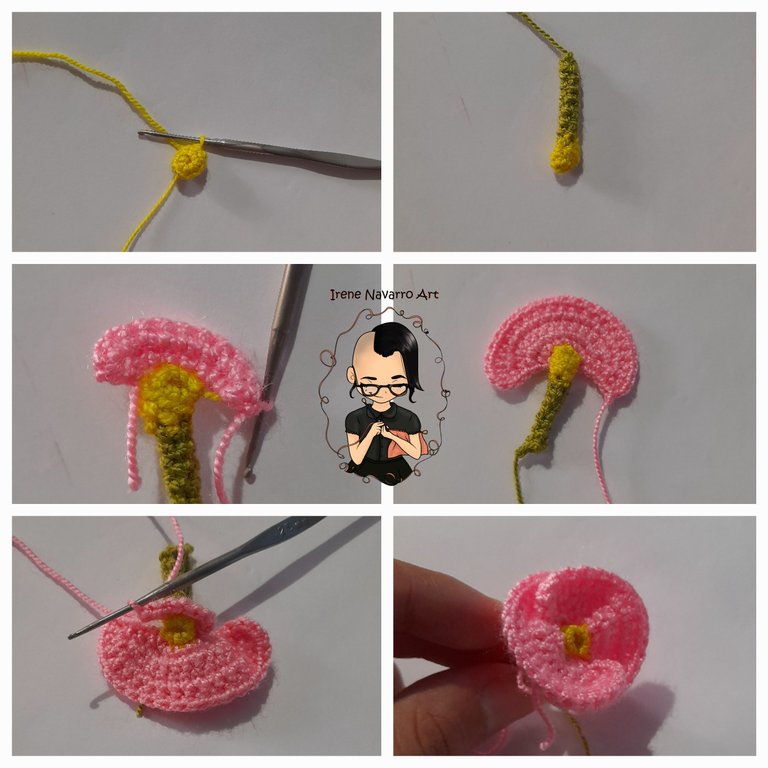

Unir dos flores por el tallo verde: hacer 2 puntos bajos en la primera flor, hacer 4 puntos bajos en la segunda, hacer 2 puntos bajos en la primera flor, para obtener 8 puntadas.
Hacer 2 puntos bajos y 1 disminución dos veces para obtener 6 puntadas.
Hacer 5 hileras de 6 puntos bajos.
Unir el resto de la flores en pares.
Para unir dos pares de flores, hacer 3 puntos bajos en el primer tallo, hacer 6 puntos bajos en el segundo, hacer 3 puntos bajos en el primero, para obtener 12 puntadas.
Hacer 1 punto bajo y 1 disminución, cuatro veces para obtener 8 puntadas.
Hacer 5 hileras de 8 puntos bajos.
De este modo se forman tres grupos de 4 flores
Join two flowers by the green stem: make 2 single crochets in the first flower, make 4 single crochets in the second, make 2 single crochets in the first flower, to obtain 8 stitches.
Make 2 single crochets and 1 decrease twice to get 6 stitches.
Make 5 rows of 6 single crochets.
Join the rest of the flowers in pairs.
To join two pairs of flowers, single crochet 3 in the first stem, single crochet 6 in the second, single crochet 3 in the first, to get 12 stitches.
Make 1 single crochet and 1 decrease four times to get 8 stitches.
Make 5 rows of 8 single crochets.
In this way three groups of 4 flowers are formed
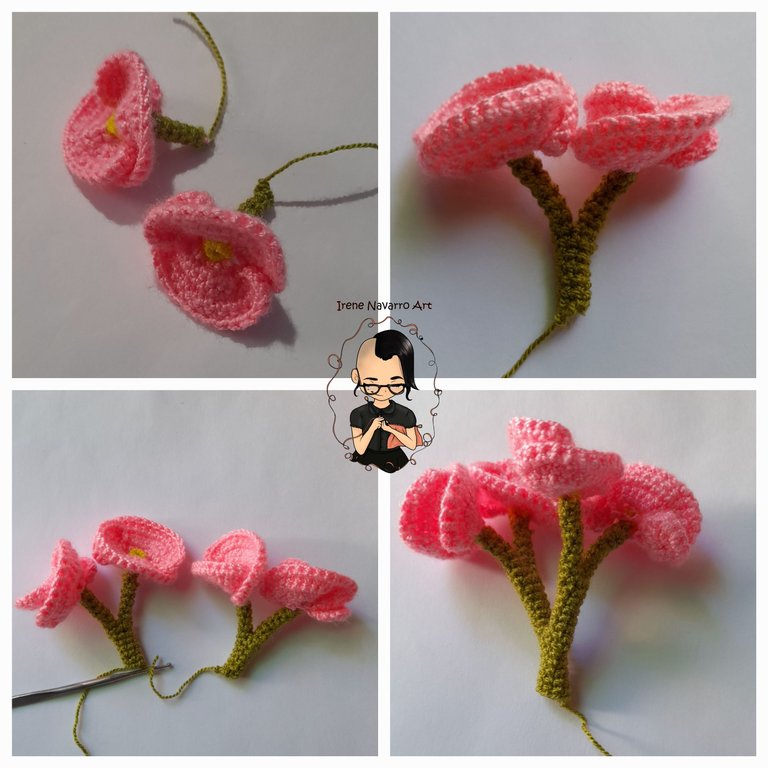

Introducir alambre en cada grupo de flores, unir los tres grupos de flores por una hilera de 24 puntos bajos.
Hacer 1 punto bajo y 1 disminución, ocho veces para obtener 16 puntadas.
Hacer 16 puntos bajos.
Hacer 2 puntos bajos y 1 disminución, cuatro veces para obtener tener 12 puntadas.
Hacer dos hileras de 12 puntadas.
Con hilo gris hacer 1 puntos bajo y 1 aumento, seis veces para obtener 18 puntadas.
Hacer doce hileras de 18 puntadas.
Introduce wire in each group of flowers, join the three groups of flowers by a row of 24 single crochets.
Make 1 single crochet and 1 decrease eight times to get 16 stitches.
Make 16 single crochet.
Make 2 single crochets and 1 decrease, four times to obtain 12 stitches.
Make two rows of 12 stitches.
With gray thread make 1 single crochet and 1 increase, six times to obtain 18 stitches.
Make twelve rows of 18 stitches.
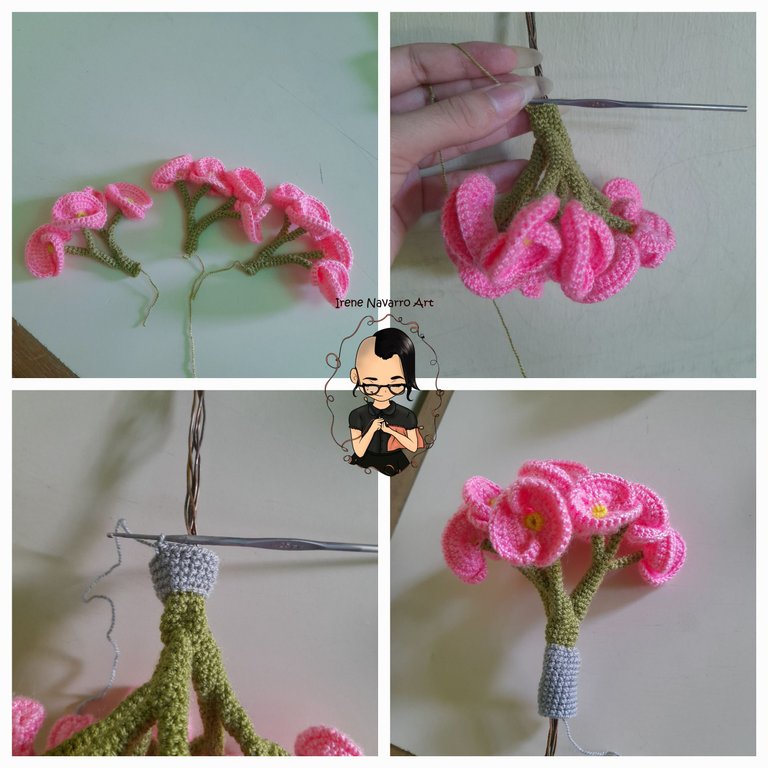

Para las hojas usar el ganchillo # 3 y el hilo verde. Comenzar con 14 cadenas de inicio.
Hilera 1: (1 aumento doble de puntos altos, 12 puntos altos, 1 aumento doble de puntos altos) X 2. Total de puntadas: 36
Hilera 2: (1 aumento doble de puntos altos, 16 puntos altos, 1 aumento doble de puntos altos) X 2. Total de puntadas: 44
Hilera 3: 44 puntos bajos.
Hacer 4 puntos bajos en circulo por dos hileras, hacer 1 punto deslizado y dejar una hebra larga para coser.
Hacer tres hojas de igual manera.
For the leaves use the #3 crochet hook and the green thread. Start with 14 starter chains.
Row 1: (1 treble crochet double increase, 12 treble crochets, 1 double treble crochet increase) X 2. Total stitches: 36
Row 2: (1 treble crochet double increase, 16 treble crochets, 1 double treble crochet increase) X 2. Total stitches: 44
Row 3: 44 single crochet.
Make 4 single crochets in a circle for two rows, make 1 slip stitch and leave a long tail to sew.
Make three sheets in the same way.
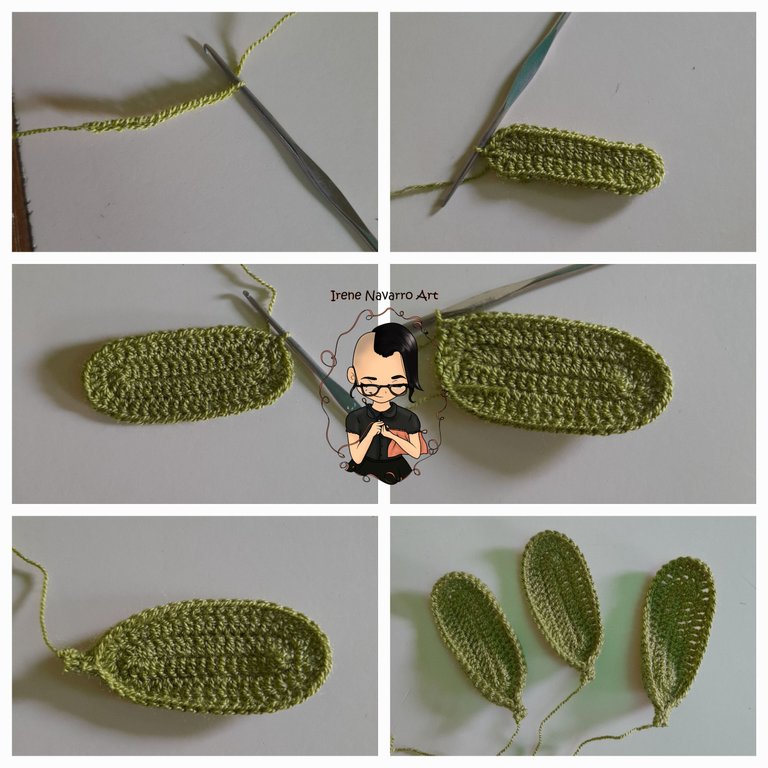

Coser la hojas a la parte gris del tallo.
Con hilo gris y ganchillo # 4 hacer las espinas:
Hacer 3 puntos bajos en un anillo.
Hilera 1: 1 puntos bajo, 1 aumento, 1 punto bajo. Total de puntadas: 4
Hilera 2: 3 puntos bajos, 1 aumento. Total de puntadas: 5
Hacer 1 puntos deslizados y dejar una hebra larga para coser.
Hacer 9 espinas y coserlas al tallo.
Con hilo marrón y ganchillo # 4, retomar las puntadas del tallo.
Hilera 1: (1 punto bajo, 1 aumento) X 9. Total de puntadas: 27
Hilera 2: (1 puntos bajos, 1 aumento, 1 punto bajo) X 9. Total de puntadas: 36
Hilera 3: 36 puntos bajos
Hilera 4: (3 puntos bajos, 1 aumento) X 9. Total de puntadas: 45
Hilera 5: (2 puntos bajo, 1 aumento, 2 puntos bajos) X 9. Total de puntadas: 54
Terminar con un punto deslizado.
Sew the leaves to the gray part of the stem.
With gray yarn and #4 crochet hook, make the thorns:
Make 3 single crochets in a ring.
Row 1: 1 single crochet, 1 increase, 1 single crochet. Total stitches: 4
Row 2: 3 single crochet, 1 increase. Total stitches: 5
Make 1 slip stitches and leave a long tail to sew.
Make 9 spines and sew them to the stem.
With brown yarn and #4 crochet hook, resume the stem stitches.
Row 1: (1 single crochet, 1 increase) X 9. Total stitches: 27
Row 2: (1 single crochet, 1 increase, 1 single crochet) X 9. Total stitches: 36
Row 3: 36 single crochet
Row 4: (3 single crochets, 1 increase) X 9. Total stitches: 45
Row 5: (2 single crochets, 1 increase, 2 single crochets) X 9. Total stitches: 54
Finish with a slip stitch.
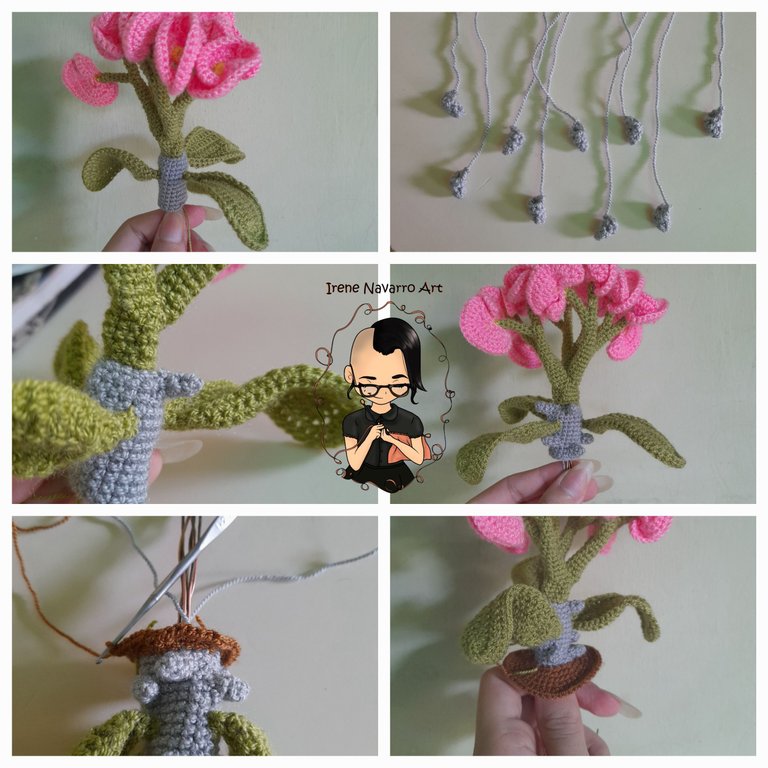

Con hilo azul y ganchillo # 3, hacer 16 puntos altos en un anillo.
Hilera 1: (1 punto alto, 1 aumento) X 8. Total de puntadas: 24
Hilera 2: (3 puntos alto, 1 aumento) X 6. Total de puntadas: 30
Hilera 3-12 : (1 punto alto, 1 cadena) X 30.
Hilera 13 y 14: 30 puntos bajos.
Introducir el frasco y coser el borde a la parte marrón de la planta.
With blue yarn and #3 crochet hook, make 16 treble crochets in a ring.
Row 1: (1 treble crochet, 1 increase) X 8. Total stitches: 24
Row 2: (3 double crochet, 1 increase) X 6. Total stitches: 30
Row 3-12: (1 double crochet, 1 chain) X 30.
Row 13 and 14: 30 single crochet.
Introduce the jar and sew the edge to the brown part of the plant.
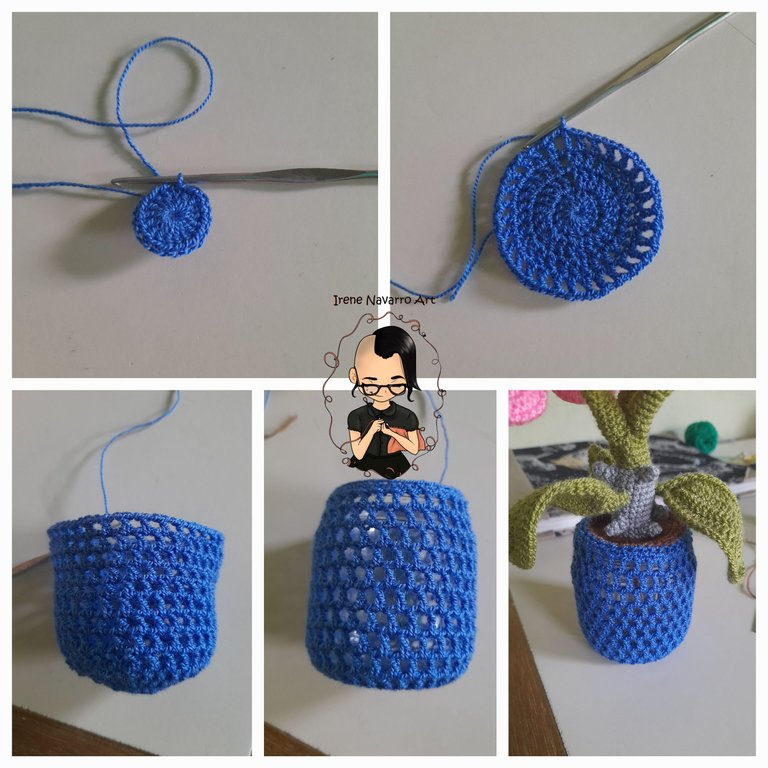

Resultado / Result
Como les mencione al principio realizar este proyecto de flores fue todo un descubrimiento, tener las flores del jardín de mi casa me permitió estudiar acerca de la morfología de la planta, es decir la manera en que se agrupan los las flores, donde del tallo se producen las bifurcaciones en tres partes luego se divide dos veces cada uno, por eso cada grupo tiene 12 flores, la naturaleza es tan simétrica y perfecta que asombra, también pude conocer que cada flor tiene dos pétalos pero que esos se superponen como una especie de espiral, la observación fue mi mejor estrategia y por eso estoy feliz de llegar hasta el final de este proyecto de manera exitosa. Si llegaste a leer todo muchas gracias 💜
As I mentioned at the beginning, carrying out this flower project was quite a discovery. Having the flowers from my home garden allowed me to study the morphology of the plant, that is, the way in which the flowers are grouped, where the stem is they produce bifurcations into three parts, then each one is divided twice, that is why each group has 12 flowers, nature is so symmetrical and perfect that it amazes, I was also able to learn that each flower has two petals but that they overlap as a kind of spiral, observation was my best strategy and that's why I'm happy to get to the end of this project successfully. If you managed to read everything, thank you very much 💜
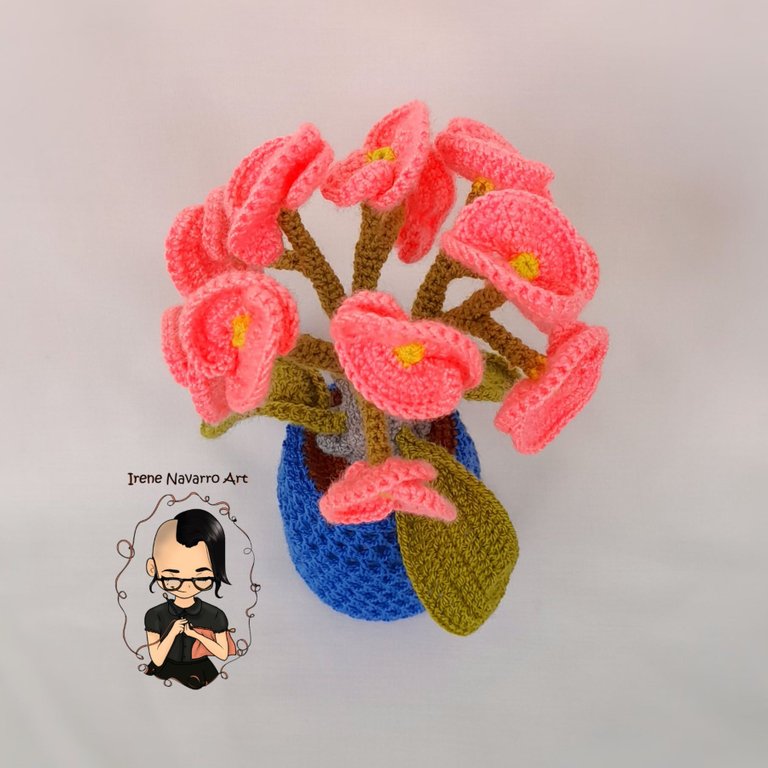
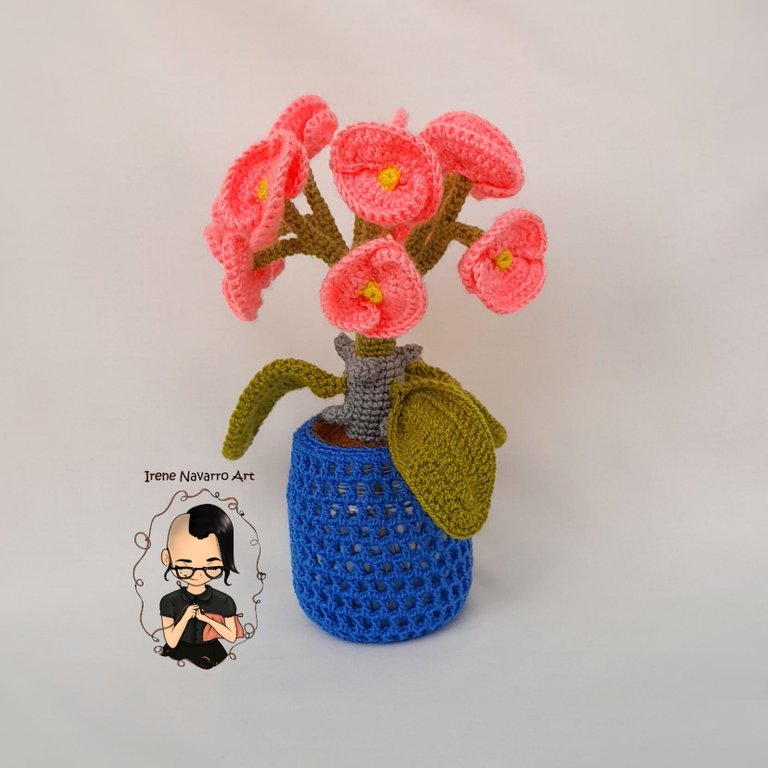

Imágenes tomadas con dispositivo Samsung A12. Portada editada en InShot
Pictures taken with Samsung A12 device. Cover edited in InShot

Espero les haya gustado. Les invito a leer mis próximas publicaciones y siempre estaré dispuesta a responder sus preguntas y comentarios, también pueden seguirme y contactarme en cualquiera de mis redes sociales. ¡Muchas gracias!
I hope you liked it. I invite you to read my next publications and I will always be willing to answer your questions and comments, you can also follow me and contact me on any of my social networks. Thank you!

